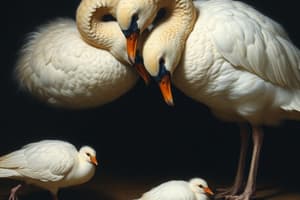Podcast
Questions and Answers
What is a common way to classify animals?
What is a common way to classify animals?
- By their habitat
- By class (correct)
- By their color
- By their weight
Which of the following animals is NOT typically classified in the reptile class?
Which of the following animals is NOT typically classified in the reptile class?
- Lizard
- Crocodile
- Snake
- Penguin (correct)
What advantage does live birth provide for reptiles in colder areas?
What advantage does live birth provide for reptiles in colder areas?
- Easier feeding of the young
- Elimination of the need to protect eggs (correct)
- Smaller size of the offspring
- More offspring at once
Which class of animals is known for living both on land and in water?
Which class of animals is known for living both on land and in water?
What type of reproduction is mainly observed in fish?
What type of reproduction is mainly observed in fish?
Which of the following represents a reproductive exception among amphibians?
Which of the following represents a reproductive exception among amphibians?
Which animals are included in the mammal class?
Which animals are included in the mammal class?
What distinguishes birds from other reptiles according to some scientists?
What distinguishes birds from other reptiles according to some scientists?
What do frog eggs have that provides protection while floating in water?
What do frog eggs have that provides protection while floating in water?
Which class includes animals that almost exclusively reproduce by laying eggs?
Which class includes animals that almost exclusively reproduce by laying eggs?
Flashcards
Animal Class
Animal Class
A group of animals that share similar traits.
Live Birth
Live Birth
A way for animals to reproduce, where offspring develop inside the mother's body and are born alive.
Laying Eggs
Laying Eggs
A way for animals to reproduce, where offspring develop inside an egg outside the mother's body.
Reptiles
Reptiles
Signup and view all the flashcards
Aves
Aves
Signup and view all the flashcards
Fish
Fish
Signup and view all the flashcards
Amphibians
Amphibians
Signup and view all the flashcards
Mammals
Mammals
Signup and view all the flashcards
Jelly Layer
Jelly Layer
Signup and view all the flashcards
Live Birth in Reptiles
Live Birth in Reptiles
Signup and view all the flashcards
Study Notes
Animal Reproduction: Egg-laying vs. Live Birth
- Animals are categorized into classes, like fish, mammals, and reptiles.
- Animals within the same class often share similar reproductive methods (eggs or live birth).
- Most mammals reproduce via live birth, while some other classes lay eggs.
Reptile Reproduction
- Reptiles, like snakes, lizards, and skinks, typically lay eggs.
- Some scientists include birds in the reptile class due to evolutionary relationship to dinosaurs.
- Crocodiles and turtles also lay eggs.
- Some snakes and lizards give birth live, a method potentially advantageous in cold climates.
Fish Reproduction
- Most fish lay eggs.
- Exceptions include some shark species (sand and ragged tooth sharks) that give birth live.
- Guppies are another example of fish that give birth live.
Amphibian Reproduction
- Amphibians, including frogs and salamanders, nearly always lay eggs, usually in water.
- Frog eggs are often encased in protective jelly.
- Some frogs (Suriname toad) give birth to live offspring.
Mammal Reproduction
- Mammals typically have live births.
- Exceptions include the platypus and echidna, native to Australia, which lay eggs.
Fun Facts about Animal Eggs
- Bird eggshells are composed of a material similar to seashells and pearls.
- Ostrich eggs are the largest terrestrial animal eggs.
- Shark eggs are pouch-shaped (mermaid's purse).
Studying That Suits You
Use AI to generate personalized quizzes and flashcards to suit your learning preferences.




